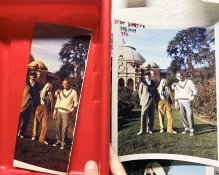I'm trying to work out how I will process RA-4 prints in my Fujimoto CP-31. In particular, how much working solution I'll need to mix for a session, how long I can use it before discarding it and starting over, plus just some of the logistics of using the processor. This will be my first time to use it. What I'm looking for is a check on my plans, plus advice from experienced printers, especially those of you who use a small roller transport system like the CP-31.
These are the publications I've based my plans on:
Z-130-04 Using KODAK Ektacolor Chemicals in Roller Transport Processors aka Using KODAK Ektacolor Chemicals in Professional Finishing Labs
Various parts of the Z-130 publications
CIS-49 Preparing Smaller-Than-Package-Size Amounts of KODAK Processing Chemicals
J39 - Tray, Drum, and Rotary Tube Processing with Kodak Ektacolor RA Chemicals
The chemicals I bought:
Kodak Ektacolor RA Developer Replenisher RT #8415580
Kodak Ektacolor RA Bleach-Fix and Replenisher #8309031
Kodak Ektacolor RA Developer Starter #1026681
Kodak Ektacolor RA Bleach Fixer Additive #8036832
My equipment consists of a Fujimoto CP-31, replenisher pump unit, and washer/dryer unit. Everything is hooked up and working, tested with water. The three baths on the CP-31 main body hold two liters of solution each. The washer/dryer unit holds 4 liters, and it has a continuous flow of water through it when in use. I will use bath 1 for developer, bath 2 for blix, bath 3 for the wash bath 1, and the w/d unit for wash bath 2.
I'll be printing only 8x10 for now. Processing time is 45 seconds per bath at 35C. Replenishment occurs each time a sheet is fed into the input rollers. I have my replenisher set for 10ml (setting 2). For 8x10 paper, that is one milliliter over the specified replenishment rate of 16.2 ml per square foot for Premier Endura paper, but only 1/3rd the specified rate for the blix (per Z-130-04). So the blix replenishment will be low, and I presume I'll need to compensate with additional replenisher periodically. I don't have a way to set different replenishment amounts for each pump, so far as I know.
I have no idea how much I'll really be able to print per session, but I'll assume 50 sheets for now. Since each bath holds 2 liters, I'll need 2.5 liters of working solution each for the developer and the blix.
I've read that at least a couple of people on the forum mix the entire batch of developer and blix (10 liters each, in my case) and store it in multiple filled containers with no air space (canning jars, for example), and they say it keeps fine for a long period of time, more than a year. However, Kodak says in J-39 that the mixed solutions in full stoppered glass containers are only good for 6 weeks for the developer and for 8 weeks for the blix.
So I plan to mix partial amounts, per the instructions in CIS-49. There are also instructions in J-39 for mixing less than full volumes. I didn't do the math, but I suspect they come out the same for the RA RT solutions. The J-39 deals with the case of mixing a single non-replenished batch in 1L increments, whereas the CIS-49 gives amounts for 1 liter increments assuming replenishment. Developer starter is only added to the initial tank amount in CIS-49 and the replenisher is used as is without added starter.
Blix (Bleach Fix and Replenisher with Additive):
The initial tank solution and the replenisher solution are the same. From table 3 in CIS-49.
Amounts for 1L, 500 ml water + 142 ml part A + 200 ml part B + 15 ml additive + water to make 1L.
Amounts for 2.5L, 1250 ml water + 355 ml part A + 500 ml part B + 37.5 ml additive + water to make 2.5L.
Developer Replenisher with Starter and extra Replenisher:
Only the initial tank solution requires developer starter. The replenisher is Developer Replenisher RT without starter.
Amounts for 1L of Developer Replenisher without starter (table 3 in CIS-49), 500ml water + 50 ml part A + 22.2 ml part B + 50 ml part C + water to make 1L.
Amounts for 1L of Developer Replenisher with starter (table 4 in CIS-49), 800 ml Developer Replenisher (from table 3) + 175 ml water + 25 ml Starter = 1L
For 2L initial tank solution with starter plus 500 ml replenisher without starter:
1050 ml water + 105 ml part A + 46.62 ml part B + 105 ml part C + water to make 2.1L
Reserve 500ml for replenishment.
To make the initial 2 liter tank solution with starter:
1600 ml Developer Replenisher + 350 ml water + 50 ml Starter = 2L
Before I get to other questions, does my math check out? Is this similar to what you do for CP-31 processing? Got any suggestions to make this simpler?
These are the publications I've based my plans on:
Z-130-04 Using KODAK Ektacolor Chemicals in Roller Transport Processors aka Using KODAK Ektacolor Chemicals in Professional Finishing Labs
Various parts of the Z-130 publications
CIS-49 Preparing Smaller-Than-Package-Size Amounts of KODAK Processing Chemicals
J39 - Tray, Drum, and Rotary Tube Processing with Kodak Ektacolor RA Chemicals
The chemicals I bought:
Kodak Ektacolor RA Developer Replenisher RT #8415580
Kodak Ektacolor RA Bleach-Fix and Replenisher #8309031
Kodak Ektacolor RA Developer Starter #1026681
Kodak Ektacolor RA Bleach Fixer Additive #8036832
My equipment consists of a Fujimoto CP-31, replenisher pump unit, and washer/dryer unit. Everything is hooked up and working, tested with water. The three baths on the CP-31 main body hold two liters of solution each. The washer/dryer unit holds 4 liters, and it has a continuous flow of water through it when in use. I will use bath 1 for developer, bath 2 for blix, bath 3 for the wash bath 1, and the w/d unit for wash bath 2.
I'll be printing only 8x10 for now. Processing time is 45 seconds per bath at 35C. Replenishment occurs each time a sheet is fed into the input rollers. I have my replenisher set for 10ml (setting 2). For 8x10 paper, that is one milliliter over the specified replenishment rate of 16.2 ml per square foot for Premier Endura paper, but only 1/3rd the specified rate for the blix (per Z-130-04). So the blix replenishment will be low, and I presume I'll need to compensate with additional replenisher periodically. I don't have a way to set different replenishment amounts for each pump, so far as I know.
I have no idea how much I'll really be able to print per session, but I'll assume 50 sheets for now. Since each bath holds 2 liters, I'll need 2.5 liters of working solution each for the developer and the blix.
I've read that at least a couple of people on the forum mix the entire batch of developer and blix (10 liters each, in my case) and store it in multiple filled containers with no air space (canning jars, for example), and they say it keeps fine for a long period of time, more than a year. However, Kodak says in J-39 that the mixed solutions in full stoppered glass containers are only good for 6 weeks for the developer and for 8 weeks for the blix.
So I plan to mix partial amounts, per the instructions in CIS-49. There are also instructions in J-39 for mixing less than full volumes. I didn't do the math, but I suspect they come out the same for the RA RT solutions. The J-39 deals with the case of mixing a single non-replenished batch in 1L increments, whereas the CIS-49 gives amounts for 1 liter increments assuming replenishment. Developer starter is only added to the initial tank amount in CIS-49 and the replenisher is used as is without added starter.
Blix (Bleach Fix and Replenisher with Additive):
The initial tank solution and the replenisher solution are the same. From table 3 in CIS-49.
Amounts for 1L, 500 ml water + 142 ml part A + 200 ml part B + 15 ml additive + water to make 1L.
Amounts for 2.5L, 1250 ml water + 355 ml part A + 500 ml part B + 37.5 ml additive + water to make 2.5L.
Developer Replenisher with Starter and extra Replenisher:
Only the initial tank solution requires developer starter. The replenisher is Developer Replenisher RT without starter.
Amounts for 1L of Developer Replenisher without starter (table 3 in CIS-49), 500ml water + 50 ml part A + 22.2 ml part B + 50 ml part C + water to make 1L.
Amounts for 1L of Developer Replenisher with starter (table 4 in CIS-49), 800 ml Developer Replenisher (from table 3) + 175 ml water + 25 ml Starter = 1L
For 2L initial tank solution with starter plus 500 ml replenisher without starter:
1050 ml water + 105 ml part A + 46.62 ml part B + 105 ml part C + water to make 2.1L
Reserve 500ml for replenishment.
To make the initial 2 liter tank solution with starter:
1600 ml Developer Replenisher + 350 ml water + 50 ml Starter = 2L
Before I get to other questions, does my math check out? Is this similar to what you do for CP-31 processing? Got any suggestions to make this simpler?
Last edited by a moderator:















